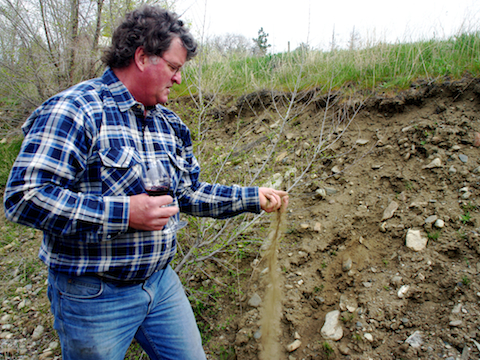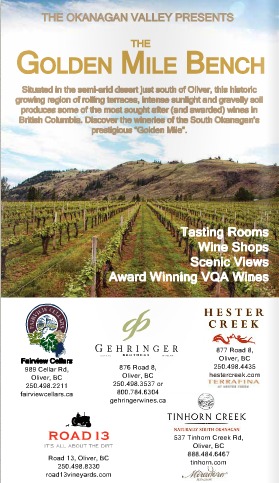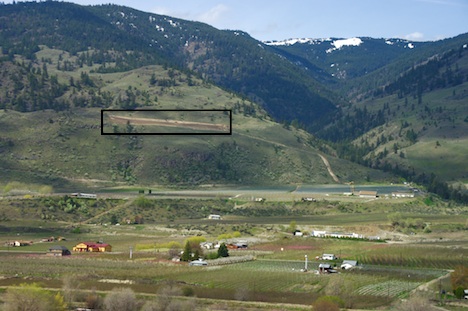
Golden Mile Bench member and Fairview owner Bill Eggert talks soil: ultimately, it really is ‘all about the dirt’
My notice regarding yesterday’s news about the Golden Mile Bench arrived too late for me to add anything to the release.
Here’s what I’ve written for the North Shore News, by way of a simplified explanation, plus some added thoughts…
This week marked a defining moment in the evolution of British Columbia’s wine industry. On May 20th a group of wineries who’ve come together under the banner of “The Golden Mile Bench” filed a formal request with the BC Wine Authority to be recognized as the province’s first sub-appellation.
Even though the sometimes contentious process has taken about five years to reach this point, If all goes to plan, the application could be approved within a few weeks or months.
DVAs explained
Currently, BC is divided into six “Designated Viticultural Areas” (DVAs), of which the Okanagan Valley is the largest, containing a range of immensely varying sites, soils and climatic conditions—in wine-speak broadly referred to as “terroirs.” Under BC wine laws, a sub-appellation, or “Sub-Designated Viticultural Area” can be approved only once a number of conditions have been met. These include completing an in-depth scientific analysis that prove the wines produced in the proposed area “consistently demonstrate distinctive characteristics related to shared soil, topography and climate, enhanced by the adoption of specific production practices.”

Last year’s independently published ‘Official Wine Tour Handbook’ included this ad for the Golden Mile Bench
A number of experts contributed to the Golden Mile Bench study, including long-time Pacific Agri Centre (PARC) Summerland viticultural research scientist Dr. Pat Bowen. My sources tell me that wines from throughout the valley were tasted in comparisons that showed consistently identifiable features from the Golden Mile Bench wines.
Designations and Divisions
The name “Golden Mile” dates from a time when Oliver once enjoyed fame as “The Cantaloupe capital of Canada.” In recent years its use has been unofficially adopted to publicize the numerous wineries that now populate the west side stretch of the valley on Oliver’s southern limits.
The proposed new designation “Golden Mile Bench” has been applied for by the dozen or so wineries (including Tinhorn Creek, Road 13, Gehringer and Culmina), on the bench above the valley floor. Some wineries below, whose vineyards do not extend to the area defined are not included, while the proposed northern boundary (also based on soil sampling) runs between Bill Eggert’s Fairview Estate Vineyard and the Quails Wayside Vineyard. Elevation is key: Culmina owner Don Triggs notes the family’s 595 metre elevation Margaret’s Bench (likely the highest vineyard in the south Okanagan) is not included.

Part of the proposed Golden Mile Bench: the box (2010 photo) shows the land prepared for Culmina’s Margaret’s Bench, which would not be included.
It’s important to note that these wineries would not have exclusive use of the term. Any winery that buys grapes from within the sub DVA could use them to make a Golden Mile Bench designated wine.
Despite the objections of those wineries excluded (who do have the option to apply for their own designation, where feasible), it’s likely the application will be approved, and the “Golden Mile Bench” will come into being.
What’s taking so long?
Under current BC regulations, the Okanagan Valley DVA is described as “the land within the watershed of the Okanagan water basin.” With the immense growth in the industry, and the emergence of so many obvious regional variations within the 250 km long valley, such a vague description has become irrelevant, failing to provide the consumer with a label that details a meaningful origin.
Ontario moved some years ago to adopt a comprehensive system of soil based sub-appellations throughout most if not all of its DVAs, which addressed existing growing regions. However, mainly for commercial reasons, BC has ignored the issue, choosing instead to be guided by major winery interests, wine tourism and brand designations that offer little indication as to from where the grapes actually came.
That begs the question: who’s next?
Or, maybe, who isn’t next?
Generally speaking (although there’s nothing ‘general’ about the boundaries defined by sub-appellations) we can eventually expect around half a dozen or more applications from the Okanagan eventually to come forward, maybe in the near future. These areas might also enjoy distinctive soils and climatic variations, as required, to make them distinct within the Okanagan Valley, contributing to the production of unique wines.
These might be portions of:
Naramata Bench
Skaha Bluffs
Westbank Bench
Kelowna Mission District
East Kelowna Bench
Black Sage Bench
Okanagan Falls
To mention a few.
Not far down the road will be the need to bestow specific DVA (Designated Viticultural Area) status on newer regions, such as The Shuswap, Kamloops, and Lillooet. Their wine activity may be small now but it promises to grow. And they are not included within any specific DVA status.
It’s worth remembering that BC’s DVAs were defined when there really was little happening outside of the Okanagan Valley—and even the latter was home to about a tenth of the land under vine compared to today.
The Golden Mile Bench is just the beginning. At least it should be.
Hi Tim;
A slight correction. The boundary actually passes through the Quail’s Wayside vineyard at the very North end of the proposed DVA.
The entire Fairview Cellars Estate vineyard is within the proposed boundary.
Cheers
Bill
Thanks, Bill! I will fix that.